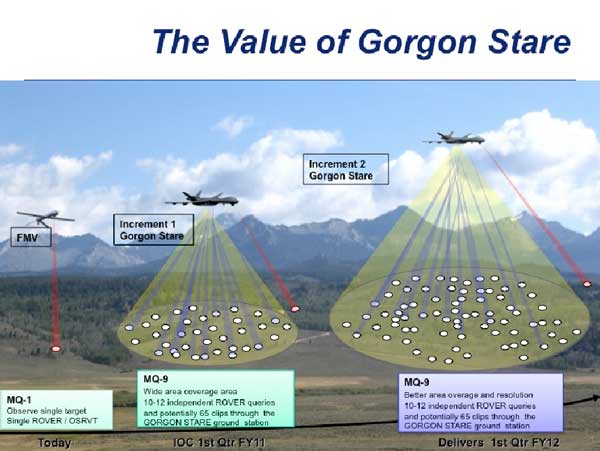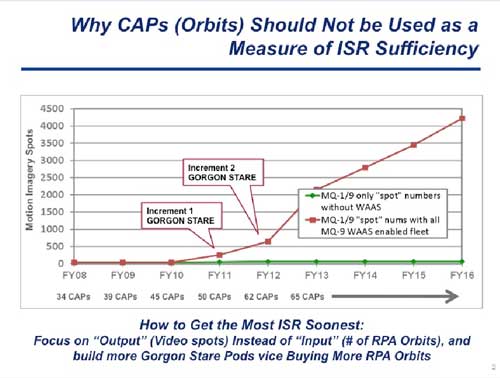Lt. General Deptula on Gorgon Stare
02/24/2011 –
 (Provided by Lt. Gen. Deptula)
(Provided by Lt. Gen. Deptula)
SLD: What does Gorgon Stare bring to the warfighting table?
Lt. Gen. Deptula: The Gorgon Stare program was developed to meet the ever-increasing demand for motion video from joint forces deployed in Afghanistan.
What motion video accomplishes at the most basic level is to increase a user’s situation awareness of what’s around him or her. That’s why it’s in such demand. Gorgon Stare is a pod set. It is two pods carried onboard an MQ-9 Reaper. It’s about thousand pounds in weight.
It is a series of optical instruments integrated together to provide a wide area image about the size of a small village. Today, the sensors onboard an MQ-1 Predator or an MQ-9 Reaper only provide a soda straw-like look at a very small area. Gorgon Stare provides a simultaneous view of the entirety of a small village.
Within that area, it can send ten motion video clips to ten separate receivers on the ground. That’s directly without any processing.
After a bit of processing of the Gorgon Stare data stream, it will be able to send out up to 65 separate video images or clips inside that area to 65 separate users. Right-off the bat then you can dramatically increase the delivery to the end user of the video image. Right now you’re only sending one video image down for each remotely piloted aircraft–with Gorgon Stare we’ll be able to distribute up to 65 motion video clips to 65 separate users per RPA. Why wouldn’t anybody want to achieve that acomplishment?
So to highlight the capabilities:
- The ability to view an entire village vice a couple of hundred feet per video clip;
- Increasing the video feed DIRECTLY to forces on the ground by an order of magnitude from a single aircraft;
- With some processing, increasing the distribution of video to up to 65 separate personnel with receivers;
- Dramatically increasing the information feed available to “second-tier” users (meaning other levels of command). value of gorgon stare
SLD: So you’ve got three advantages right off the bat. One, the coverage is greater. Secondly, you can broadcast directly to an individual soldier. And thirdly, you can go to a process station that can then reconfigure it. So, it won’t get jammed, for example, just by that distribution you’ve created a jamming nightmare for an adversary because of the distribution.
Plus, I assume also, because it’s a pod that happens to currently on the Reaper, but it doesn’t have to be on the Reaper, you could put it on a different system. So, it’s independent of the platform, so to speak.
Lt. Gen. Deptula: Absolutely. But by the way, this is why we in the Air Force stopped producing MQ-1 Predators, because they simply didn’t have the payload capacity of the Reaper. Believe it or not there were people in the Pentagon who were upset with this decision to stop buying Predators because Reapers were individually more expensive. On one system we may pay twice as much for the platform, but we are going to get 65 times more motion video. It doesn’t take a rocket scientist to figure out the overarching value for what you get is much, much more. In fact with respect to motion video it’s up to 33 times more cost effective.
SLD: People tend to confuse the initial cost of an individual platform with the cost of a deployed asset or a fleet of assets that yield value for money.
Lt. Gen. Deptula: Right. Here’s the other piece that has tended to lose some people. It is very hard for people to break away from focusing on platforms or the aircraft and get them to think about the output that comes off of these platforms.
And so the nominal approach for some in high places in the Pentagon is to focus on increasing the number of aircraft that host motion video to gain more orbits. Well it’s not the Orbits that are flown by the aircraft that matter; it’s the output coming off the host aircraft.
So, we are now buying 15 more orbits of MQ-9s to deploy to Afghanistan at some point in time. However, there’s no more ramp space to put the additional 15 orbits-worth of aircraft.
If Gorgon Stare pods were procured instead, we could dramatically increase the motion video output of the MQ-9s we already possess, and achieve a much greater effect in providing the forces on the ground what they need than we would by buying more aircraft to fly single-ball sensors.
 (Provided by Lt. General Deptula)
(Provided by Lt. General Deptula)
SLD: My favorite term is C4ISR-D to refer to the point of why you have C4ISR, namely to make better decisions at the appropriate level. The fact that I’m giving this video to individual soldiers in a real situation, whether they need to be reassured of what’s in front and around them. And also to anticipate what they’re going to have to do. It goes directly to them to use now.
Lt. Gen. Deptula: People don’t understand that. Many are concerned about what we are going to do with all this data that’s coming these increased output capabilities? Some are concerned that we are not going to be able to process all of it. Well, part of the solution is that the best processor of this information when it goes directly to a warfighter in the battlespace, is the processor that exists between his or her two ears. There is value in simply increasing the situation awareness of our fighters on the edge of the battlespace.
This is game changing technology because it will dramatically increase the situation awareness of our deployed warfighters by well over an order of magnitude than what we can provide today
SLD: And you’re directly giving him extends his range of vision to deal with a COIN combat situation. So it increases his competence and capacity. But beyond that, what you just described is a major improvement of an ability of a combat soldier to survive, prevail and succeed.
Much of the criticism published to date about Gorgon Stare seems to miss the point entirely of what the system was designed to do. Also, the criticisms are driven by a pre-decisional, draft report that was significantly revised before its actual release.
Lt. Gen. Deptula: Part of the problem is the test program was using means to measure Gorgon Stare effectiveness that were not related to what the capabilities that the system provides. They were looking at a motion video clip. They stop the clip, they blow up an image from one of the stop-motion video clips, and then they determine that the resolution of the stationary clip did not measure up to fixed imagery standards—well it’s not designed to fixed imagery standards.
They were using measures of merit for fixed imagery, not appropriate for this program or mission. It is not meant to achieve high resolution of a still picture. It’s meant to provide images of motion activity. That’s why that the final test report was different than the draft test report—those kind of mismatches of analysis to the designed effects were finally adjusted.
Nobody’s claiming that this first iteration of wide-area airborne surveillance is perfect. The reason we have tests is to determine what is it that’s not working so that we can fix it and move on.
But throwing your hands up in the air because “oh my gosh, guess what… a test program identified some things that need to be fixed.” That’s not a surprise; that’s why we do tests.
SLD: This gets to the question of acquisition processes. And what people have forgotten is acquisition is about buying things. And here is an example of buying the 80% solution and putting it into the field relatively quickly. So this is exactly what Secretary Gates asked for but critics are commenting on having greater performance and then deploying. This is not the process we are looking at right now to augment capabilities for the ground forces at risk today.
Lt. Gen. Deptula: Don’t let the perfect be the enemy of the good enough. Get me a 70-percent solution that we can get out there now, as opposed to years from now.

